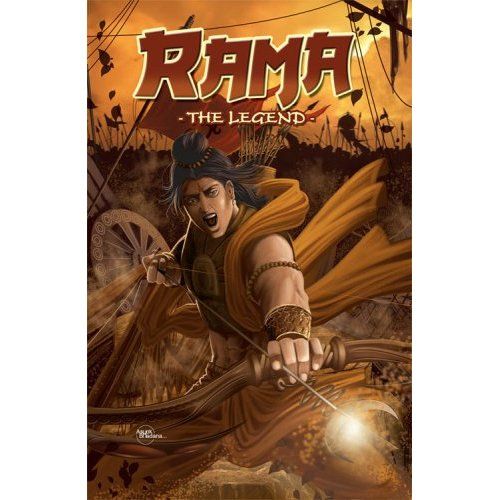"Rama, the Legend," a full-length graphic novel published by Arcana Comics, has the following words on its back cover: "Ramayana is not just a literary monument, it is held in such reverence that the mere reading or hearing of it can set individuals free from sin and grant every desire to the reader or hearer." Besides being awkwardly phrased (why not just stop the sentence after the word "desire"?), the back cover text hardly sets up the reader for what's inside the graphic novel. A transcendent experience, it is not. No, indeed. Not even close.
This graphic novel has two main problems: the writing and the art. The lettering's amateurish as well, with some word balloons using a smaller font not because it makes sense in the story, but because all those words couldn't fit in that size bubble.
Let's start with the writing, though, because this is clearly B. Albers Jackson's project, since she writes the whole thing, along with providing a lengthy introduction about Hindu culture and the significance of this graphic novel. Jackson is a terrible comic book writer, one who violates almost every rule of the medium. She uses captions to tell us what the panels clearly show us, and falls into a kind of juvenile storybook narration of the "this happened, then this happened, then this happened" variety. Instead of using dialogue to develop characterization, she gives characters declarative sentences without any kind of subtext. That may be partly the fault of the original source, since this is meant as an adaptation of an ancient text, but Jackson certainly didn't feel the need to stick closely to the source material at other points in the graphic novel.
I haven't read the "Ramayana," but I'm pretty sure that it doesn't contain a goofy crow who wears a baseball cap. "Rama, the Legend," does. Let me clarify that. In a graphic novel which is meant to retell the story of Rama, the great Hindu epic hero -- the man who faced multi-headed evil gods and flying poisonous snakes with only his companions and his bow and arrows -- well, we get all that, plus a goofy crow who narrates bits of the story while wearing a baseball cap. It's like Poochie has risen up out of his "Simpsons" grave and made this ancient Hindu text 110% more extreme! How embarrassing for everyone involved.
The art isn't a complete failure, but it's not close to the kind of professional comic book illustration you would expect from a fifteen-dollar graphic novel. The characters move stiffly, like inarticulate action figures, and when Ashok Bhadana does try to show some expression, the mouths he paints don't line up properly with the faces. This is a comic with headband-wearing apes, sea serpents, and soldier bears, and it's painted as if those were the most uninteresting things on the planet. There is a strange kind of otherworldly hue to Bhadana's work that fits the tone of the graphic novel, but the individual figures, the page compositions, and the storytelling is inferior in every way.
When Virgin Comics began its line of comics based on Indian mythology, this is the type of stuff everyone feared. But Virgin was able to avoid this level of quality by putting together professional-looking projects and taking the mythology in a new, intriguing direction. Arcana's "Rama, the Legend" falls into every trap Virgin avoided. It's a tonally inconsistent piece of ridiculousness, bound in the cloth of sincerity. It tries so hard to make this story "cool" for a 21st century Western audience and it fails in every way. It's only worth may be as a slice of camp absurdity, like those unintentionally hilarious educational films of the 1950s.

